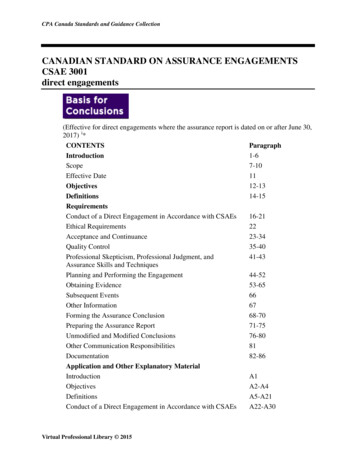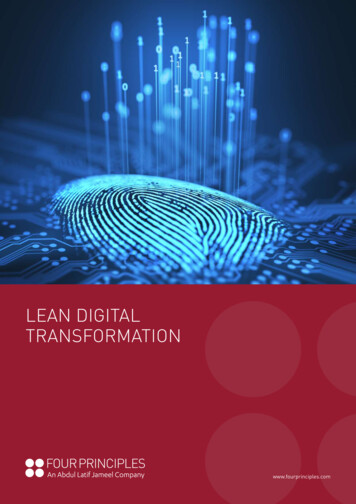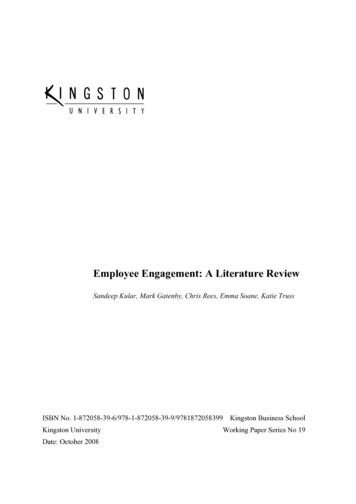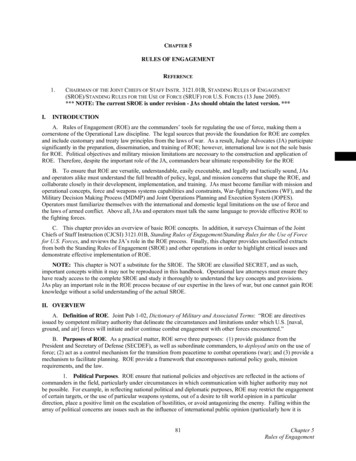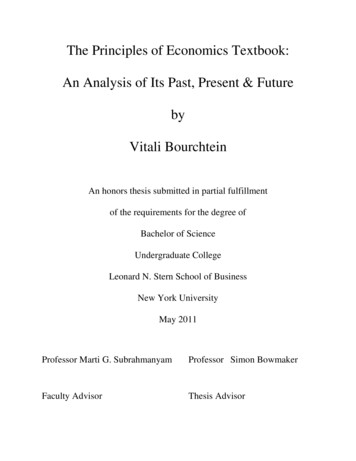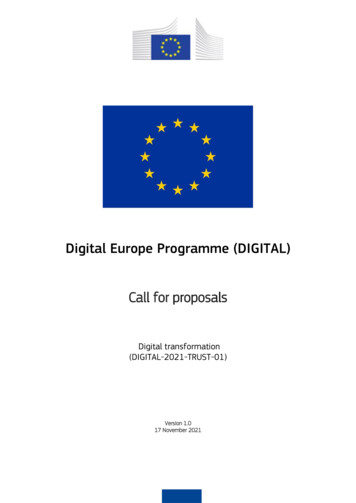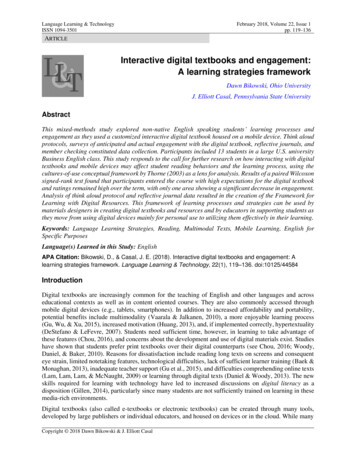
Transcription
Language Learning & TechnologyISSN 1094-3501February 2018, Volume 22, Issue 1pp. 119–136ARTICLEInteractive digital textbooks and engagement:A learning strategies frameworkDawn Bikowski, Ohio UniversityJ. Elliott Casal, Pennsylvania State UniversityAbstractThis mixed-methods study explored non-native English speaking students’ learning processes andengagement as they used a customized interactive digital textbook housed on a mobile device. Think aloudprotocols, surveys of anticipated and actual engagement with the digital textbook, reflective journals, andmember checking constituted data collection. Participants included 13 students in a large U.S. universityBusiness English class. This study responds to the call for further research on how interacting with digitaltextbooks and mobile devices may affect student reading behaviors and the learning process, using thecultures-of-use conceptual framework by Thorne (2003) as a lens for analysis. Results of a paired Wilcoxonsigned-rank test found that participants entered the course with high expectations for the digital textbookand ratings remained high over the term, with only one area showing a significant decrease in engagement.Analysis of think aloud protocol and reflective journal data resulted in the creation of the Framework forLearning with Digital Resources. This framework of learning processes and strategies can be used bymaterials designers in creating digital textbooks and resources and by educators in supporting students asthey move from using digital devices mainly for personal use to utilizing them effectively in their learning.Keywords: Language Learning Strategies, Reading, Multimodal Texts, Mobile Learning, English forSpecific PurposesLanguage(s) Learned in this Study: EnglishAPA Citation: Bikowski, D., & Casal, J. E. (2018). Interactive digital textbooks and engagement: Alearning strategies framework. Language Learning & Technology, 22(1), 119–136. doi:10125/44584IntroductionDigital textbooks are increasingly common for the teaching of English and other languages and acrosseducational contexts as well as in content oriented courses. They are also commonly accessed throughmobile digital devices (e.g., tablets, smartphones). In addition to increased affordability and portability,potential benefits include multimodality (Vaarala & Jalkanen, 2010), a more enjoyable learning process(Gu, Wu, & Xu, 2015), increased motivation (Huang, 2013), and, if implemented correctly, hypertextuality(DeStefano & LeFevre, 2007). Students need sufficient time, however, in learning to take advantage ofthese features (Chou, 2016), and concerns about the development and use of digital materials exist. Studieshave shown that students prefer print textbooks over their digital counterparts (see Chou, 2016; Woody,Daniel, & Baker, 2010). Reasons for dissatisfaction include reading long texts on screens and consequenteye strain, limited notetaking features, technological difficulties, lack of sufficient learner training (Baek &Monaghan, 2013), inadequate teacher support (Gu et al., 2015), and difficulties comprehending online texts(Lam, Lam, Lam, & McNaught, 2009) or learning through digital texts (Daniel & Woody, 2013). The newskills required for learning with technology have led to increased discussions on digital literacy as adisposition (Gillen, 2014), particularly since many students are not sufficiently trained on learning in thesemedia-rich environments.Digital textbooks (also called e-textbooks or electronic textbooks) can be created through many tools,developed by large publishers or individual educators, and housed on devices or in the cloud. While manyCopyright 2018 Dawn Bikowski & J. Elliott Casal
120Language Learning & Technologyare largely-static replicas of print counterparts, others are designed specifically for digital mediums and canthus integrate the affordances of mobile technology and a variety of digital resources into a singlecustomized package. Thus, educators and writers of materials are increasingly able to create digitaltextbooks that are both interactive and customized to their educational context. As these textbooks can bespecifically designed to target the course objectives, to deliver course content and text models, and withlearner needs and broader cultural context in mind, they are an attractive option for English for specificpurposes (ESP) courses. A customized interactive digital textbook which was created for university levelBusiness English will be explored in this study.The majority of research on digital textbooks explores those that are electronic versions of print texts (e.g.,Chou, 2016; Huang, 2013; Lam et al., 2009), while relatively little research considers those that arecustomized (e.g., McFall, 2005) to the device or context; no research was found on the use of customizedinteractive digital textbooks with non-native English speaking (NNES) students. Survey studies of studentsatisfaction have revealed that the majority of student experiences are neutral or negative (e.g., Baek &Monaghan, 2013; Lam et al., 2009), and closer consideration suggests potentially negative changes instudent learning behavior (e.g., Daniel & Woody, 2013) and a “crucial disjuncture when moving fromprint to digital ” (Evans & Po, 2007, p. 56). Some may interpret these findings as calling for a return toprint-based textbooks. Yet, it may be that students are ill-equipped for such learning, given that learnerprocesses and strategies for digital texts are largely shaped outside the classroom, while their learningexperiences are largely print-based within a classroom. As they transition to using their devices foracademic in addition to personal purposes, students need to put forth extra “effort and involvement inproductive learning activities,” two key components of engagement that Kuh (2009, p. 6) identifies. Whileengagement can provide the motivation students need to navigate this new learning environment, the designof the digital textbook must also be considered, and it cannot be assumed that users will automaticallybecome successful learners. As such, the importance of customizability becomes clear and learner trainingbecomes crucial.This exploratory study thus responds to the call for further research of digital textbooks as they supportlearning (Gu et al., 2015) and “how the conventions of readings shift when students interact with digitaltexts” (Evans & Po, 2007, p. 70), specifically with NNES students (Huang, 2013) developing disciplinarywriting skills. It seeks to move beyond the examination of student perception or preference and explorestudents’ learning processes, strategies (i.e., conscious employment of a learning process), and engagementas they use a customized interactive digital textbook. It is based on a broad application of the cultures-ofuse conceptual framework of activity theory by Thorne (2003, 2016), which “provides a lens through whichto explore, and potentially to pedagogically address, tool socialization and its variabilities andconsistencies” (Thorne, 2016, p. 188). The framework also suggests that learners’ limited exposure todigital text mediums and limited use of mobile digital devices in educational contexts may affect how theyengage with such materials for learning.Literature ReviewDigital Textbooks in the ClassroomResearch on digital textbooks has focused more heavily on classes for native-English speaking (NES)students, but findings provide important considerations for NNES students as well. Most studies focus onpreferences and utilize surveys, with many finding that students prefer print to digital textbooks. Baek andMonaghan (2013) found that only 34% of the over 600 NES students surveyed indicated feeling satisfiedwith their publisher-created digital textbook. Older students were more likely to report positive opinions,perhaps due to younger students’ use of computers for entertainment over academic purposes. The authorsadvocate the use of faculty-created customized digital textbooks. Working with 12 NNES students, Lam etal. (2009) found that participants who used publisher-created digital textbooks for extended periodsexpressed more negative opinions than those who used them for shorter times. Measuring students’perceptions initially and over time can thus provide more in-depth information.
Dawn Bikowski and J. Elliott Casal121Other research moves beyond surveys and focuses on students’ learning and experiences. Daniel andWoody (2013) found no differences in NES students’ learning (measured through quiz scores) when usingprint versus digital textbooks, though students using the digital textbooks were shown to require more timefor reading and to spend more time on a range of non-academic activities than they did while reading printbased versions of the same text. The authors question the efficacy of asking students to learn with the samedevices they utilize for personal use without providing sufficient training. Yet, while Daniel and Woodypoint out the draw that the technology can have on students’ attention, others have noted students’difficulties in engaging with these technologies. Evans and Po (2007) found that their 12 NESundergraduate participants were “unable to engage with digital texts” largely due to “their previousinteractions with technology” (p. 70). Similarly, McFall (2005) found that many features of the customizeddigital textbook were challenging and unfamiliar, and therefore not utilized by the 33 undergraduate NESparticipants. The author underscores the importance of design and customization in learning with digitaltextbooks, noting that training must include critical reading skills. Training in this area is particularly salientgiven that each new online reading experience potentially requires a different set of skills and strategies(Leu et al., 2011).Customization is critical with disciplinary writing and learning in ESP, which is a pragmatic, needs-basedapproach to language teaching and learning within specific contexts (Belcher, 2009) such as BusinessEnglish. This customization is increasingly occurring via technology (e.g., authentic videos and texts,communication with professionals). Technology offers students many affordances, meaning it offers a“‘match’ between something in the environment and the learner” (van Lier, 2004, p. 96). With thesenew environments, however, comes the need for new learning strategies.NNES students cannot necessarily rely on familiar strategies as they read and learn with digital textbooks(Chou, 2012). Reading on a screen introduces new challenges (e.g., distinct annotation procedures, eyestrain) to what many find an already daunting task. As of yet, no studies have outlined the processes andstrategies these students utilize as they engage in this new context. Research into processes learners use inother learning contexts has moved beyond surveys and added cognitive-based methods such as think aloudprotocols (TAPs), which are useful for understanding problem solving and cognitive functions while usingtechnology-based learning tools (e.g., Okuyama & Igarashi, 2007; Sun, 2003; Vinther, 2005) and duringsecond language reading (Brown & Rodgers, 2002).Evolving Pedagogical Practices and TrainingThe inconclusive findings about digital textbooks may be surprising, considering the prominence of digitaltexts in society and educator expectations, but they also highlight the gap between their societal (e.g., socialmedia) and educational uses (e.g., digital textbooks, learning management systems). Following the work ofKessler, Bikowski, and Boggs (2012) we can reframe this gap as an opportunity, a space wherein tools,pedagogical practices, and use can “co-evolve” (p. 105) for successful learning. Kessler et al. explain thatchanges in a developing tool or use require new or revised pedagogies, broadly suggesting that successfulpedagogical practices are conceived with tools and student usage patterns in mind. Likewise, there is littlereason to expect that the ways we use technology in our everyday lives are optimized for or even compatiblewith learning; learners may require training for learning and need to be engaged in the learning process.Hubbard (2004) distinguishes between operational and learning competence in his discussion of training.Learners may struggle and resist, as Thorne (2003) finds in computer-mediated communication contexts,or ignore technologies they do not perceive as useful, as Conole, de Laat, Dillon, and Darby (2008) find.Instructors may need to make deliberate efforts to foster learning relationships between students and theirdigital textbooks and devices. Hubbard (2004) supports this view in arguing that effective training developslearner awareness of the connection between learning objectives and technology-based resources. Acomponent of this connection is engagement, which can be the path for students as they expand their usefrom solely personal to academic. How students expect the digital textbook to affect their engagement,compared to how they reflect on its actual impact, has not been measured.
122Language Learning & TechnologyTheoretical FrameworkIn his cultures-of-use conceptual framework, Thorne (2003, 2016) highlights the importance of tools andhow their use (including for learning) is determined by society: “The design of the tool as well as thehabitual patterns of its use influence the purposes to which it is put and methods by which it is used”(Lantolf, Thorne, & Poehner, 2015, p. 209). The way a tool (or artifact) is used leads to a culture-of-use;for example, a tablet can fit into a personal or academic culture-of-use. Thorne (2003) found that a learner’sprior artifact-mediated activity can either facilitate or constrain their future learning activity. These culturalartifacts become empowered within specific contexts. As such, critical, academic engagement with amediating learning artifact may lead to increased feelings of engagement and positive educationaloutcomes, but these cannot be expected to arise naturally and can benefit from teacher guidance and peerdiscussions.The studies discussed above track digital texts or textbooks in distinct contexts, but one similarity is thattraining users for learning competence with such resources does not occupy a central role. Even thoughLam et al. (2009) include limited training in their study, the focus appears to be on operational competence.While learners in these studies may have begun with, developed, or even been trained for capacity to usedigital texts or textbooks (e.g., navigation features, functionality of notetaking tools), there is little evidencethat they were trained to learn from them (e.g., previewing, notetaking strategies). As such, a poorlydeveloped academic culture-of-use surrounding these texts and a lack of learning strategies may haverepresented a learning barrier and discouraged learner engagement. Participants were placed in innovativelearning environments, but they were not necessarily fully prepared to succeed.Taken together, these findings reveal that (a) reading and learning with digital textbooks is at least aschallenging as learning with print texts, (b) the design of digital textbooks must be considered, (c) manylearners are unsure of how to learn with them, and (d) training is therefore crucial. Previous efforts to utilizedigital textbooks have not included conscious efforts to establish an academic culture-of-use surroundingthe resource or digital device and have not capitalized on the opportunity that customization can provide indisciplinary contexts. As such, this exploratory study provides insights into the nature of NNES students’experiences with a customized interactive digital textbook after they have used the book for the course andundergone consistent training. Participants were in a university-level first-year Business English course;the digital textbook had gone through prior usability testing and was fully embedded within the curriculum.This study is driven by the following research questions:1. To what extent do students report engagement (anticipated and actual) with the digital textbook,and what is the nature of that engagement as they are developing an academic culture-of-use?2. What learning processes and strategies are part of students’ developing academic culture-of-use asthey are trained to use an interactive and customized digital textbook?Methods and MaterialsSetting and ParticipantsThe context chosen for this study was a first-year 15-week Business English course in a large MidwesternU.S. university. This project-based course had a local non-profit organization focusing on environmentaleducation as a client, with students researching collaboratively in small teams (of three to four people) andengaging in business genres (e.g., memos, progress reports, analytic reports). The overall goal of the coursewas to support students as they developed higher-level writing skills to help them succeed in businesscourses and their careers. This course was chosen since it required customized materials, collaboration, andtechnology use and offered students sufficient time to develop the strategies needed for learning with thedigital textbook (Chou, 2016).Participants were 13 fully-matriculated undergraduate students: their average age was 22 (range, 20–24);there were nine females and four males; their native languages were Mandarin Chinese (9), Arabic (2),
Dawn Bikowski and J. Elliott Casal123Japanese (1), and Dutch (1). All students owned a smartphone or a tablet. On average, participants felt verycomfortable using their smartphone or tablet at the beginning of the course (M 4.38/5.00, SD 0.77) andused it for a variety of tasks: interacting in social media (M 13.35 hours/week, SD 15.34); reading digitalbooks (M 8.5 hours/week, SD 9.86); reading the news (M 4.35 hours/week, SD 3.59); watchingmovies (M 4.31 hours/week, SD 3.25); studying, learning, or using educational apps (M 4.15hours/week, SD 3.16); playing games (M 3.54 hours/week, SD 4.70); checking email (M 2.65hours/week, SD 1.70); and shopping online (M 1.92 hours/week, SD 1.79). Some participants alsowrote digitally via personal blogs, news commentary, or product and media reviews. Seven of the 13students had used a digital textbook created by a publisher; none reported using a customized digitaltextbook.Digital Textbook Used for this StudyThe digital textbook was created as an iBook due to this platform’s features regarding stability, interactivity,and the affordances offered within the device (an iPad). Students who did not own an iPad were lent oneduring the term. For simplicity, the customized interactive digital textbook used in this study will be referredto as a digital textbook, with customized and interactive being understood. The digital textbook includedcourse materials (e.g., syllabus, rubrics) as well as content chapters which explored issues related toprofessional writing (e.g., considering audience) and the course project (e.g., challenges facing non-profitorganizations), with examples from students’ home countries integrated when possible (e.g., relevantexamples of non-profit organizations). Design principles followed in order to reduce cognitive loadincluded having shorter readings (approximately 30 minutes) with bulleted material and sufficient whitespace; integrating learning tools and hyperlinks within and outside the iBook; and interspersing text withhighly connected images, videos (open source or custom-made), and interactive content (e.g., selfassessment quizzes, links to Google Forms homework tasks). Guidelines followed regarding design from alearning perspective included allowing students to collaborate, maintain control, use previous experiencesand knowledge, and give and receive feedback within the digital textbook and device (e.g., see Lim, Song,& Lee, 2012). The digital textbook underwent several iterations of usability testing, focusing on theattributes of learnability, effectiveness, and efficiency (see Kessler & Plakans, 2001; Lim et al., 2012). Thebook was used, tested (via student surveys, observations, and in-class discussions), and revised eight timesprior to this study to maximize progress toward the course objectives.Procedure and AnalysisA phased research design was used, following Vinther (2005). During Phase I (Weeks 1–2), all participantstook an anticipated engagement survey and six participated in the first round of TAP. This informationinformed the reflective journals and training students received in Phase II (Weeks 3–10). Phase III (Weeks11–15) included the survey of actual engagement, the final TAP, and member checking. This triangulationof data collection improved the credibility, dependability, and confirmability of qualitative andintrospective data (Brown & Rogers, 2002).Engagement SurveyEngagement with the digital textbook was measured via surveys (Week 1: anticipated; Week 11: actual).Handelsman, Briggs, Sullivan, and Towler’s (2005) Student Course Engagement Questionnaire, created forcollege students, was modified and used (see Table 1). Based on theories of motivation and amultidimensional definition of engagement, this survey was tested for validity and reliability. It has beenmodified and used in other learning technology research, such as with studies of engagement within onlinelearning (Dixson, 2010; Young & Bruce, 2011). An overall question and 15 items were included from thethree factors (i.e., skills, emotion, and participation and interaction) that related to this study and to thedefinition of engagement utilized by Kuh (2009): effort and involvement. Three questions were re-wordedslightly for relevance (similar to Dixson, 2010) or for clarity to NNES students, and one question was addedabout the digital environment. Participants rated the questions on a 5-point Likert scale, per Handelsman etal. (2005), and spaces for comments were included. Questions asked the extent to which participants
124Language Learning & Technologyanticipated the digital textbook would (term initial) and then actually did (term final) influence them invarious behaviors and feelings. General demographic and computer-use questions were also included.Distributing the survey in Week 1 also allowed for the identification of potential participants for the TAPs.Potential participants were identified based on total time spent on two activities: hours/week reading digitalbooks and hours/week studying, learning, or using educational apps. Of the 13 participants, the three withthe lowest total hours, the three closest to the mean total hours (M 12.65 hours/week), and the three withthe highest total hours were invited. Of those nine, six agreed to participate in the TAPs: one from the lowerthree (3.5 hours/week), all three closest to the mean (11, 13, and 16 hours/week), and two from the upperthree (23 and 33 hours/week). P1 (Participant 1), P2, P3, and P5 were native Chinese speakers, P4 Japanese,and P6 Dutch.The same engagement survey was given during Week 11, but with verbs changed to the past tense. AWilcoxon signed-rank test was used to compare participants’ anticipated and actual feelings of engagementwith the digital textbook. This non-parametric test was chosen given the non-normal distribution of the dataset. The effect size (r) was calculated as the Z score divided by the square root of N minus any ties (LarsonHall, 2010).Think Aloud ProtocolsThis study used both concurrent (verbalizing thoughts during decision making) and retrospective(verbalizing thoughts after decision making but while they are still in short-term memory) TAPs (Kuusela& Paul, 2000) with material participants had not yet seen. The two types were used in order to minimizedata collection concerns and given that researchers often utilize both (e.g., Chamot & Kupper, 1989;Charters, 2003). This study followed established guidelines for collecting data using TAPs, includingparticipant training, task design, and researcher behavior (Ericsson & Simon, 1993). Retrospective TAPquestions were informed by the notes taken during the concurrent TAP and by the possible strategies andprocesses identified in the literature. Sessions (ranged 30–45 minutes) were videotaped and transcribed. Noparticipants appeared to have difficulties with the TAP.The Phase I TAP analysis (Week 2) followed a two-cycle coding system (Miles, Huberman, & Saldaña,2014), moving from provisional (initial summary of the data) to pattern coding (grouping provisional codesinto themes). Codes were informed by learning and reading strategies used by second language learners(Chamot & Kupper, 1989; Grabe, 2009; Oxford, 1989), strategies and processes used by learners usingtechnology (Okuyama & Igarashi, 2007; Sun, 2003; Vinther, 2005), and Hubbard’s (2004) operational andlearning competencies training framework. The coding scheme followed Gu’s (2014) recommendation tobe grounded in a theoretical framework but expanded to include more detail and examples. This codingscheme resulted in the Framework for Learning with Digital Resources (see Table 6) and was used toidentify training needs (a 6-point training plan) during Phase II as well as the analysis of TAPs in Phase III.The Phase III (Week 11) TAP was analyzed qualitatively according to the guidelines established byCharters (2003) and Gu (2014). A qualitative lens was chosen given the small sample size (six TAPparticipants) and the purpose of this study. Gu (2014) notes the importance of understanding students’motivations in using a strategy over simply obtaining quantitative tallies of presence or absence codes. TAPsessions were analyzed by coding each comment or behavior into the coding scheme created in Phase I (seeTable 6). Two raters (one of the researchers and a research assistant) independently rated 25% of thevideotaped TAP sessions. Given strong interrater reliability (96.25%), the two researchers completed theremaining coding. By the sixth and final TAP participant, Gu’s (2014) recommendation to reach the pointof data saturation was accomplished, and analysis demonstrated that the coding scheme was comprehensive.Training and ImplementationThe 6-point training plan carried out in Phase II (Weeks 3–10) was developed out of the coding schemeand framework developed in the Phase I TAP (see Table 6), which was itself influenced by Hubbard’s(2004) competencies framework. Training was collaborative, student-centered, and adaptive, emphasizing
Dawn Bikowski and J. Elliott Casal125critical awareness of learning decisions and reflective practices. Each week, students engaged in a varietyof brief activities designed to prepare them for learning with the digital textbook and to develop criticalthinking skills (Sun, 2003). These activities can be broadly grouped according to purpose: introduction offeatures or strategies, implementation of behavior into personal practices, and reflection on effectivenessof behavior and needs. Tasks included brief demonstrations, classroom activities using the technology,personal reflective journals, and collaborative discussion of strategies with peers to develop their ownmetacognitive awareness (Chamot & Kupper, 1989). To emphasize peer learning, particular emphasis wasplaced on “collaborative debriefings” (Hubbard, 2004, p. 54) that created recurring spaces for learners toshare and reflect on their strategies while thinking toward future activity.Reflective JournalsReflective Journals in Phase II (Weeks 3–10) allowed for the inclusion of a broader range of participants’experiences. Reflective journal topics were based on the coding scheme and the literature on engagement(Kuh, 2009) and digital literacy (Gillen, 2014). They included academic uses (notetaking, reading online,writing papers or assignments, and experiences with print vs. digital textbooks) and potential engagement(describing their learning experience with the digital textbook). The journal entries were analyzed andincluded in the results to provide more in-depth understanding to the engagement survey and to the TAPs(see Lam et al., 2009).Member CheckingMember checking, also termed respondent validation (Phase III), allowed for increased participantperspectives and credibility in the analysis (Gu, 2014; Lincoln & Guba, 1985). Two of the six TAPparticipants chose to participate, spending approximately one hour each. Participants were shown thecoding and asked to look for misrepresentations, errors, or inaccurate codes, and if they felt that the codingtreated them with respect. The participants asked many questions and discussed the coding and project withthe researcher; neither participant identified any areas of inaccuracies or errors in the coding, and thus nochanges were made. The checking process added to the credibility of this study in that participantssupported the data collected and its analysis.ResultsOverall, students (N 13) were very satisfied (M 4.33/5.00, SD 0.72) with the digital textbook andstrongly recommended that it be used for future courses (M 4.27/5.00, SD 1.16). Only one student didnot recommend a digital textbook, commenting that they were difficult for notetaking and not motivatingbased on past experiences, although the same student expressed strong satisfaction (M 5.0) for the digitaltextbook used for this class. In comparing digital to print textbooks, one reflective journal commentexpressed a preference for this particular customized digital textbook but indicated that often there is nodifference. Reasons (from reflective journals) for preferring this digital textbook over print textbooksincluded increased flexibility and learner control (e.g., more flexible reading experience), increasedengagement and interest (e.g., We truly are more connected to this book), increased learning (e.g., ThisiBook can make me understand more about the concept), and ease of use and convenience. In addition tooverall satisfaction with the
Language(s) Learned in this Study: English APA Citation: Bikowski, D., & Casal, J. E. (2018). Interactive digital textbooks and engagement: A learning strategies framework. Language Learning & Technology, 22(1), 119–136. doi:10125/44584 Introduction Digital textbooks are increasingly commo
